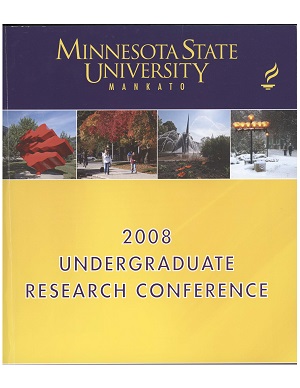Examination of Mycobacterium avium Subspecies Paratuberculosis for the Formation of Organic Films in Culture
Location
CSU Ballroom
Start Date
21-4-2008 1:00 PM
End Date
21-4-2008 3:00 PM
Student's Major
Biological Sciences
Student's College
Science, Engineering and Technology
Mentor's Name
Timothy Secott
Mentor's Department
Biological Sciences
Mentor's College
Science, Engineering and Technology
Second Mentor's Name
Michael Bentley
Second Mentor's Department
Biological Sciences
Second Mentor's College
Science, Engineering and Technology
Description
Mycobacterium avium subspecies paratuberculosis (Mpt) is the causative agent of Johne's Disease, a chronic, often fatal intestinal disease of cattle. Little is known about how Mpt is able to survive outside of the animal host. In our laboratory. Mpt has been observed, to form sheet-like structures in extended culture, This may suggest that Mpt can form a biofilm which may enable it to survive in the environment. The purpose of this study was to observe the structural organization of this matrix. To determine the presence of structure, the organisms were presented with a surface upon which they could adhere. Upon examination by scanning electron microscopy, several cell morphologies were noted, along with a strand-like material linking one organism to another. Coccoid cells, coccobacilli, and bacilli, along with irregularly shaped objects which may represent cell remnants, were found to be massed together. Voids which seemed to appear at regular intervals within the matrix were also observed. The morphology of cells which formed the exterior of the voids were more commonly coccoid.
Examination of Mycobacterium avium Subspecies Paratuberculosis for the Formation of Organic Films in Culture
CSU Ballroom
Mycobacterium avium subspecies paratuberculosis (Mpt) is the causative agent of Johne's Disease, a chronic, often fatal intestinal disease of cattle. Little is known about how Mpt is able to survive outside of the animal host. In our laboratory. Mpt has been observed, to form sheet-like structures in extended culture, This may suggest that Mpt can form a biofilm which may enable it to survive in the environment. The purpose of this study was to observe the structural organization of this matrix. To determine the presence of structure, the organisms were presented with a surface upon which they could adhere. Upon examination by scanning electron microscopy, several cell morphologies were noted, along with a strand-like material linking one organism to another. Coccoid cells, coccobacilli, and bacilli, along with irregularly shaped objects which may represent cell remnants, were found to be massed together. Voids which seemed to appear at regular intervals within the matrix were also observed. The morphology of cells which formed the exterior of the voids were more commonly coccoid.
Recommended Citation
Waisanen, Cody. "Examination of Mycobacterium avium Subspecies Paratuberculosis for the Formation of Organic Films in Culture." Undergraduate Research Symposium, Mankato, MN, April 21, 2008.
https://cornerstone.lib.mnsu.edu/urs/2008/poster-session-B/20



